A Private Tour today in North Norfolk, looking mainly at waders. It has been unusually windy for March in the last couple of weeks and it was another windy day today as ‘Storm Graham’ swept in from the Atlantic and across the country. The peak gust recorded on the coast was an impressive 62mph! We had discussed rearranging the day, but a decision was made to press ahead and we were glad we did. It was dry all day, with some brighter intervals, and we saw lots of waders despite the wind.
It was not meant to be a particularly big tide today, but with the strong wind we thought it might be a little higher than forecast. With high tide scheduled for just after 10am, we headed up to Snettisham first to see what the waders were doing there. On our way, we saw a few birds of prey enjoying the breeze – several Red Kites and a couple of Common Buzzards.
As we made our way in past the first pits, there weren’t many ducks out on the water, apart from a few Mallard and a handful of Wigeon. A female Goldeneye was standing on a concrete block at the bottom of the bank preening. You don’t often see them out of the water, but it was very choppy today and the Goldeneye had probably found a sheltered spot out of the wind.
Up on the seawall, the wind was whistling in across the open expanse of the Wash. It was immediately clear that the water was indeed a lot higher than might have been expected without the gales today. There was still some exposed mud further down, so we carried on down the track. On our way, we could see a few waders huddled down on the shore. The Oystercatchers were fairly easy to see, and a couple of Turnstones were picking around the tideline but the first Ringed Plover we found had tucked itself in behind a small mound of dried vegetation to try to get out of the wind and was very well camouflaged.

A couple of flocks of Golden Plover shot past, twisting and turning in the wind, and we saw a few small groups of Knot and Sanderling flying back and forth over the water. We made our way down to Rotary Hide where we could get out of the wind and look out over the area of still exposed mud.
There were several flocks of Dunlin feeding around the small muddy pools just in front of the hide, which we had a look at through the scope. A Sanderling appeared with the Ringed Plovers around the base of the old jetty, but disappeared behind the pillars. Then four more Sanderlings dropped in with one of the groups of Dunlin. It was good to see the two of them side by side – the Sanderlings much paler, silvery grey above and white below, with a shorter, straighter bill.
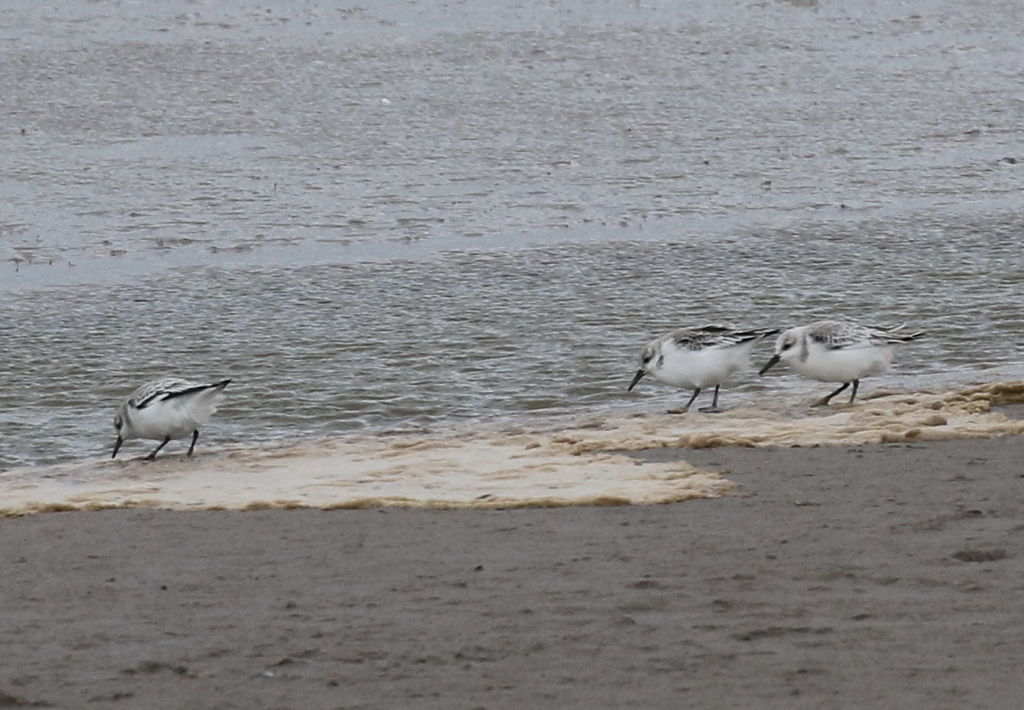
There were a few Redshank down at the front too, and one or two Grey Plover. Further back, we could see lots more waders in bigger flocks out around the edge of the water. There were a couple of large, black flocks of Oystercatcher and some little huddles of Knot and Bar-tailed Godwits nearby, with a much larger flock of Knot back in the distance.
Looking out at the pits the other side, we could see a large roost of Avocets on one of the islands down closer to Shore Hide, so we decided to brave the wind again and walk down there. It was certainly an impressive flock of Avocets all huddled on the end of the island, several hundred all packed tightly together. Over the last month, they have returned in numbers ahead of the breeding season.

At one end of the Avocets were four browner Black-tailed Godwits – we could see their long, straight bills – and on the next island back was a large flock of roosting Redshank.
A pair of Pink-footed Geese were swimming between the islands. Most of the Pink-footed Geese which spent the middle of the winter here have left already, gone north on the start of their protracted journey back to Iceland for the breeding season, but a few linger on. Through the scope, we could see their dark heads and delicate bills with a restricted pink band, very different from the larger, paler Greylags nearby with their big orange carrot bills. There was a single Canada Goose with them.
Otherwise, there were a few Wigeon and a small group of Shoveler on the pit. A couple of Goldeneye were diving down at the far end, where a line of Cormorants were roosting on one of the islands. A Little Egret was huddled under the brambles on the bank and a Little Grebe surfaced just in front of the hide.
Moving on, we drove north and stopped at Hunstanton on our way round the coast. There were lots of gulls loafing around on the green as we parked, mostly Black-headed Gulls but with a single smart adult Common Gull in amongst them. There has been a Purple Sandpiper roosting and feeding on the groynes here, but as we walked down to the prom we could see the tide was still much higher than it should be, held up by the strong wind, and the waves were still crashing over the sea defences.
We walked up to the start of the cliffs and could see several small groups of Oystercatchers and Turnstones roosting on the rocks on the beach, but despite looking through them carefully we could not find the Purple Sandpiper. In spite of the weather, there were some people clambering over the rocks, which probably didn’t help. As we walked back to the van, there were three or four Turnstones on the seawall which as usual were very obliging.
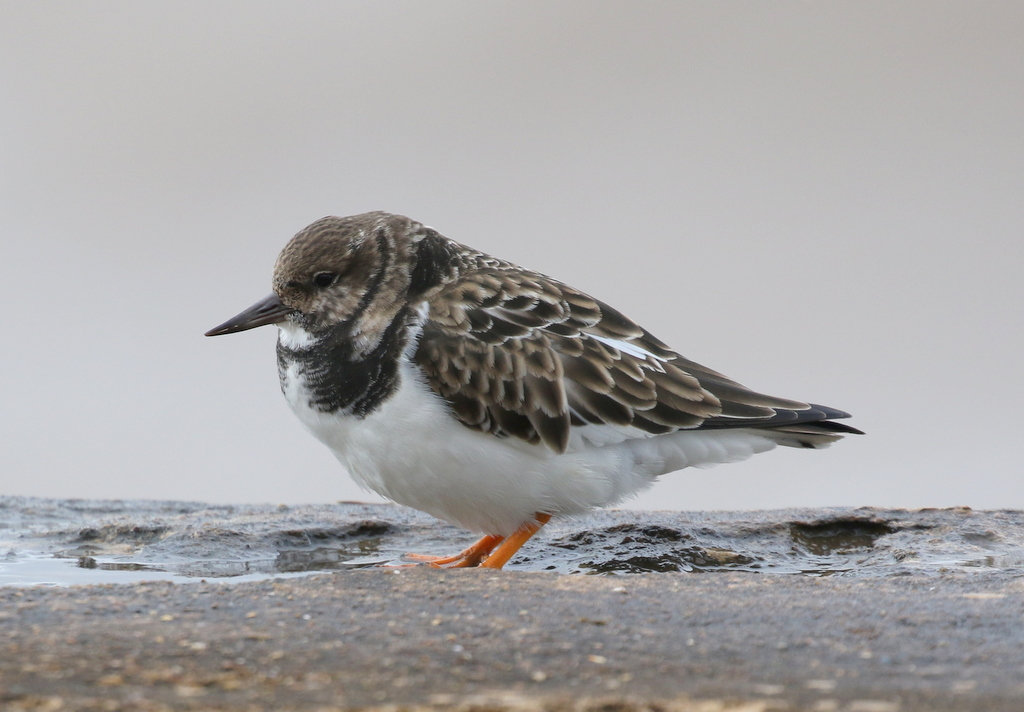
It was lunchtime by the time we got to Titchwell, so we stopped for something to eat and a welcome hot drink by the Visitor Centre. There were lots of birds coming and going from the feeders. After lunch, we had a quick look for the Water Rail in the ditch by the main path. We had thought it might be fairly sheltered down in the ditch, but the wind was whistling in through the trees and bushes and there was no sign of anything there.
A Muntjac was huddled down in the bushes behind the feeders on the far side of the Visitor Centre as we made our way round to Fen Trail and out to Patsy’s Reedbed. We had come out here mainly to see if we could find the Common Snipe which have been feeding in the cut reed out along the front edge. There were three of them there but they were well camouflaged, their golden yellow stripes matching the colour of the surrounding reed, and hidden in the vegetation at first. Eventually one came out into the open where we could get a clearer look at it.
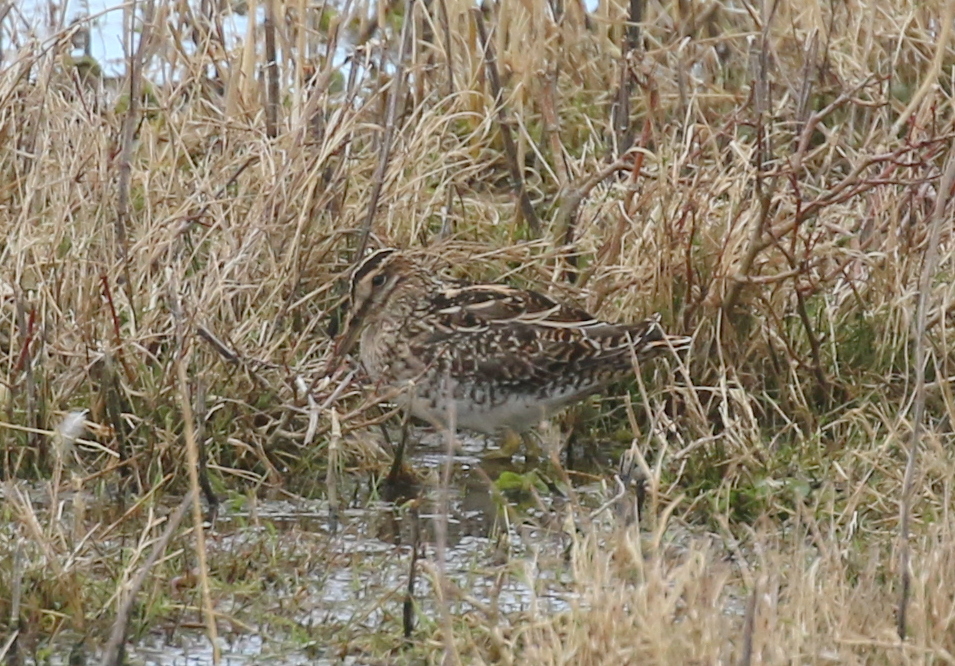
One or two Marsh Harriers hung in the air over the reedbed and from time to time a Mediterranean Gull would fly over calling, flashing its pure white wing tips. A Cetti’s Warbler shouted at us from the reeds. There were a few ducks on the water – a pair each of Tufted Ducks and Common Pochard over at the back and a few Gadwall down at the front. We got the scope on one of the drake Gadwall for a closer look, stopping to admire its intricately patterned plumage. Not a boring grey duck after all!
We made our way back round via Meadow Trail to the main path. As we got out of the trees, it was not as windy as we had feared. There were not many ducks out on the reedbed pool, but a Little Grebe was diving in one of the smaller pools just by the main path. A line of Knot flew over the saltmarsh and seemed to go down towards the Freshmarsh, so we headed down to the shelter of Island Hide.
There are lots of Avocets back here now too and several of them were feeding in front of the hide. The water level on the Freshmarsh is still very high and they were up to their bellies in the water and occasionally had to resort to swimming! More of them were clustered around the small island over by the path to Parrinder Hide.
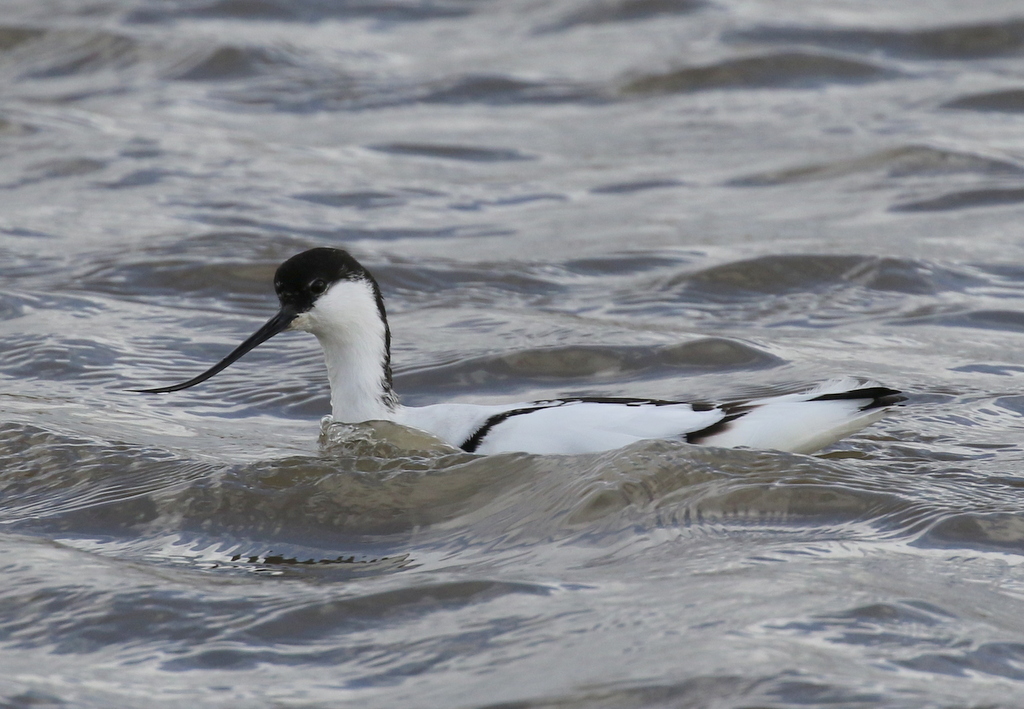
The Knot we had seen flying in across the saltmarsh were bathing and preening along the front edge of the small island too when we arrived. We got the scope on them for a better look – they were a little closer than the ones we had seen earlier out on the Wash. Otherwise, there weren’t many waders on here still.
Duck numbers of most species have dropped now, particularly Teal and Wigeon, but there were still a few on the Freshmarsh. There seemed to have been an increase in the number of Shoveler, with quite a few swimming around the island where all the waders were roosting. We had a closer look at those too and looked at the differences compared to the drake Shelduck which was in front of the hide. A large noisy flock of Brent Geese flew in from where they had been feeding on the field by the entrance track and landed on the water.
As we made our way round to Parrinder Hide, we had an even closer view of some of the Knot on the same island. Then as we walked down along the path to the hide, they started to fly over to the Volunteer Marsh low over the bank, with several right over our heads.

It was nice and sheltered in Parrinder Hide. A Curlew out in the water in front of the hide was the first we had seen today. We had come here primarily to get a better look at the Mediterranean Gulls which are getting ready to nest on the fenced off Avocet Island, along with all the Black-headed Gulls. It was a good opportunity to compare the two – the Mediterranean Gulls now starting to sport their black hoods and the Black-headed Gulls ironically having brown ones!
Looking out over the Volunteer Marsh from the other side of Parrinder Hide, there were a few Common Redshanks in front of the hide and we could see all the Knot feeding in the vegetation in the middle. We got a Grey Plover in the scope for a closer look, still in its winter plumage, grey below. Another Curlew was sheltering behind a clump of vegetation back towards the main path.
We decided to make a quick dash out to the beach to see if any waders were feeding out on the mussel beds. A Black-tailed Godwit was walking along the channel on the Volunteer Marsh just below the main path but flew off as we approached. The diminutive Teal were more obliging and we stopped to admire a couple of drakes which looked absolutely stunning in the afternoon sunshine.
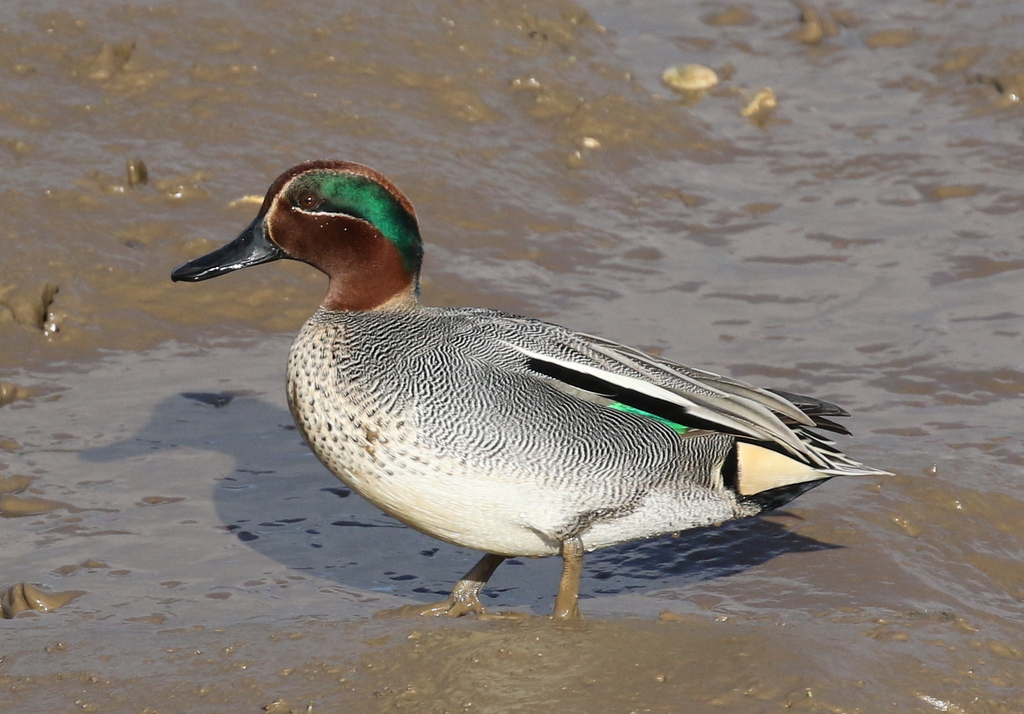
There were more waders feeding in the channel on the far side of the Volunteer Marsh and we got a look at one of the Black-tailed Godwits here in the scope. Then it was heads down and over the bank. There was nothing on the island on the non-Tidal Pools so we continued straight on to the beach.
Despite it being not far off low tide now, the mussel beds were still covered by the sea. There were some flocks of Oystercatchers roosting with the gulls along the beach towards Brancaster. Looking the other way, we could see more waders scattered along the sand towards Thornham Point, but they were all quite distant. Thankfully we managed to find a closer Bar-tailed Godwit just beyond the old bunker in front of us – the one species here we hadn’t yet managed to get a good look at. We could see its upturned bill and pale sandy upperparts streaked with dark.
After a quick walk back to the van, we heard a Bullfinch calling in the car park and looked across to see a smart pink male perched up in the white blackthorn blossom in the corner, before it flew back into the bushes.
We still had time for a couple more stops on our way back. First we drove round to Thornham Harbour. We could see a few Common Redshanks and Black-tailed Godwits in the channel as we arrived and as we walked over to one of the jetties we could see a paler wader in the water in the bottom, a Spotted Redshank in its silvery grey winter plumage, just what we were hoping to find here.

Only a very small number of Spotted Redshanks stay here through the winter, with the vast majority heading further south, to the Mediterranean or on to Africa. We had a great view of this one as it walked up and down in the water, sweeping its long, needle-fine bill from side to side in the shallows.
At one point, the Spotted Redshank stopped next to two Common Redshanks which were feeding on the muddy bank behind. As well as being slightly bigger and longer billed, it was noticeably paler with a more obvious pale superciliun between the bill and eye. We had a quick scan of the rest of the harbour, but there was no immediate sign of the Twite here this afternoon and we didn’t have time to explore more widely now.
As we made our way back east, we stopped briefly in Brancaster Staithe. There were several waders around the harbour and we had some nice views of them from the shelter of the van. A very close Ringed Plover was feeding with a similar sized Dunlin right where we pulled up. Further back, there were several Oystercatchers and Turnstones picking around the piles of discarded mussels.

A Grey Plover was feeding down by the water’s edge and further back we could see a couple of Bar-tailed Godwits too. It was lovely late afternoon light now too, which showed them off to their best.

Our final quick stop of the day was at Holkham. A white shape out on the grazing marshes drew our eye and we got the scope on a Spoonbill feeding in one of the deep pools. It spent most of the time with its head down, but when it moved from one pool to another we had a good view of its yellow-tipped spoon-shaped bill and bushy nuchal crest. Another Spoonbill was perched in the trees out in the middle, along with a well hidden Grey Heron and a lots of Cormorants.
There were a few geese out on the grazing marshes but our eye was drawn to five smaller geese down at the front, half hidden behind the trees. We got the scope on them and we could see they were Russian White-fronted Geese, lingering winter visitors here. We could see the white surround to the base of their bills and black belly bars.
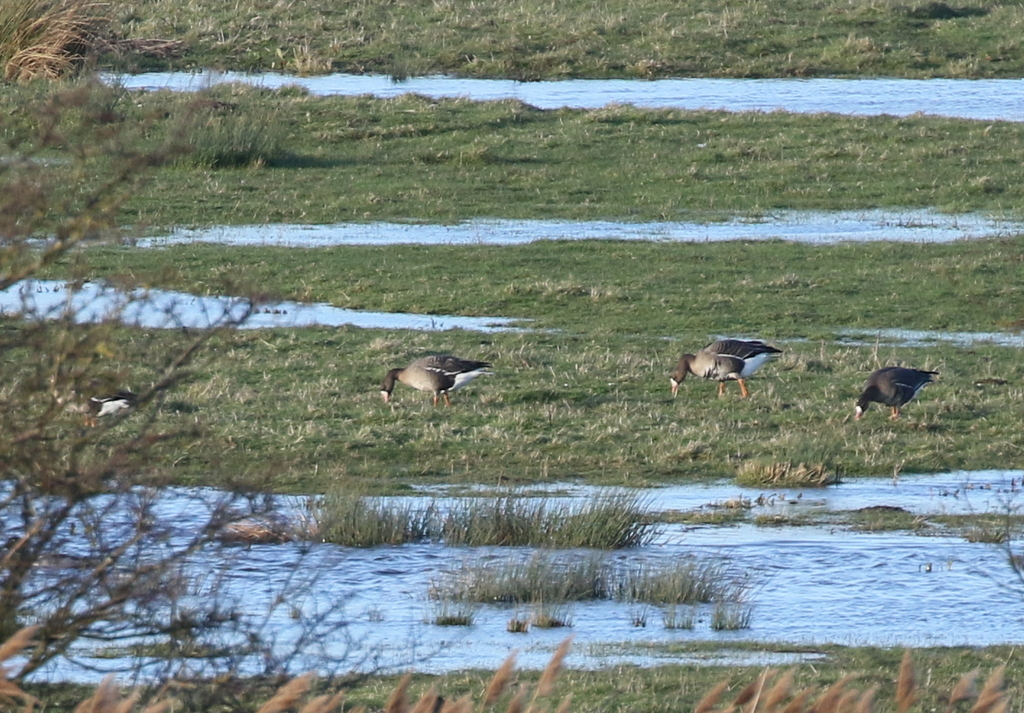
A Marsh Harrier was enjoying the breeze, flying up and down over the reeds in front of the grazing marshes, but that was not the bird we had come here primarily to see. Ironically, after spending all day looking for waders, we had still not seen a Lapwing! We found a couple around one of the closer pools on the grazing marsh and got one in the scope, an appropriate way to bring our wader-filled day to a close.
















